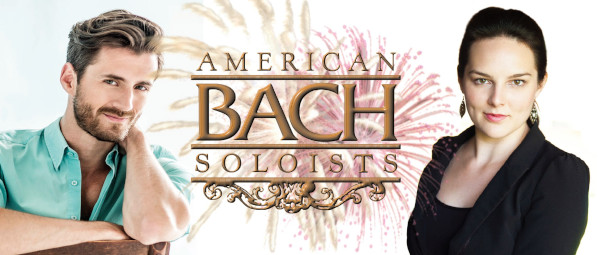
SURPRISE BAROQUE THRILLS AND TRILLS
Credit the Bach Soloists for filling the week’s vacuum around New Year’s with goodies, specifically by addressing that yawning concert void we have before and after the most celebrated Eve since, well, maybe Adam.
On the year’s final afternoon they paraded forth a splendid cornucopia of baroque operatic arias with two imported vocalists, and even an authentic period-instruments orchestra of 27 playing as if Frederick the Great himself was in the boxes at Herbst Theatre, demanding the best.
I’m delighted that the American Bach Soloists have very little interest in staging baroque opera. They not only spare the expense but also the inactivity: one solo singer after another trotting on stage in finery and singing, then trotting off in the old “canto-qui” mode (definition below). And half the male roles sung by women in so-called trouser roles. Even Handel’s Londoners gave up on staging baroque operas, shifting to plain-vanilla oratorio concerts focusing on music rather than whole royal palaces reconstructed.
The stylish Mezzo Sarah Coit left the trousers back home in Florida in bringing back to life these challenging coloratura arias in Italian. Singing these fast, highly ornamented pieces is like threading the needle vocally and turning it all into flawless embroidered designs. She emulated the great California mezzo Marilyn Horne of nearly a half-century ago.
Placid music? Hardly, as when she launches into the passionate and ultra-florid Handel “Shaken by Ferocious Storms” (“Riccardo I”) in which her anger mirrors the storm itself. Or bursting forth in “After Black and Gloomy Night” from Handel’s “Ariodante,” which brought down the house.
It took later composers to produce the duets and ensembles that became the galaxies of opera. The best that the Soloists could manage for a finale was the famous and ardent love duet finale of Monteverdi’s “Coronation of Poppea,” all transposed downward for mezzo and baritone—a sublime duet that might not be by Monteverdi at all, as it never popped up at all till a later out-of-town revival of the opera.
Already cast in the S.F. Opera’s forthcoming production of Handel’s “Partenope” rarity, the Briton Hadleigh Adams was the co-star, secure but somewhat mannered, bringing rich bass-baritone tones into the mix.
Jeff Thomas’ adroit instrumental ensemble gave us a good approximation of supple baroque sound, with natural horns, deftly grasped violin bows and cellos that never touch the floor. Major instrumental solos—in effect, duets with those solo arias—came from Sadie Glass, horn, William Skeen, cello, and Bethanne Walker, (wooden) flute. Thomas, a tenor long since converted to conducting, led the holiday ensemble mostly drawn from his American Bach Soloists regulars.
Herbst’s orchestra seating was sold out, suggesting possible future repeats to fill the New Year’s far too voided week.
MUSIC NOTES and “canto-qui”—A colleague had witnessed an S.F. Opera rehearsal (most likely Mozart) in the late 1940s when the great Metropolitan Opera basso Ezio Pinza came onto the stage and asked, “Canto qui?” (i.e., do I sing the aria at this spot?). Si, si!
Even two centuries after the baroque era’s conclusion, tradition still left us too many operas with scant stage direction, just marking the spot to sing with an invisible X. Only then did a new wave of stage directors appear en masse—Felsenstein, Wieland Wagner, Ponnelle, Zeffirelli—to inject the operatic drama we now take for granted.
A BAROQUE NEW YEAR’S EVE matinee by Jeff Thomas leading American Bach Soloists and vocalists Coit and Adams, Herbst Theatre, S.F. For ABS info call (415) 621-7900, or go online: americanbach.org.